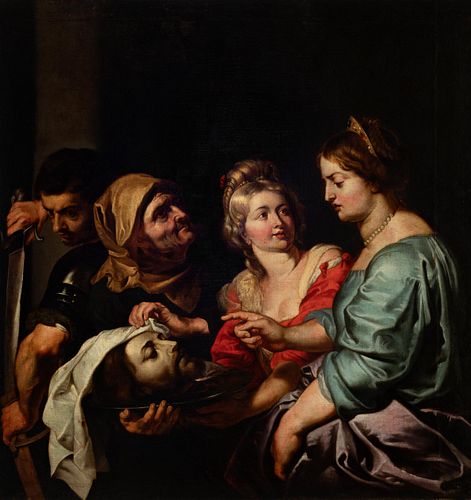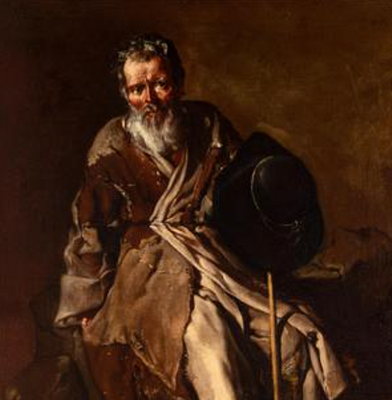GERARD SEGHERS (Flanders, 1596 - 1651). "Salome and Herodias with the Baptist's Head," ca. 1625. Oil on canvas. Re-drawn in the 20th century. Apprecia
Lot 48
About Seller
Setdart Auction House
Carrer Aragó 346
Barcelona
Spain
Setdart Subastas was born in 2004 and is currently the first online art auction in Spain with solidity, prestige and reliability guaranteed by our more than 60,000 users. Setdart has a young, dynamic and enterprising team ready to successfully manage the purchase and sale of art works through custom...Read more
Estimate:
EUR€50,000 - EUR€60,000
$53,763.44 - $64,516.13
Absentee vs Live bid
Two ways to bid:
- Leave a max absentee bid and the platform will bid on your behalf up to your maximum bid during the live auction.
- Bid live during the auction and your bids will be submitted real-time to the auctioneer.
Bid Increments
| Price | Bid Increment |
|---|---|
| EUR€0 | EUR€10 |
| EUR€200 | EUR€25 |
| EUR€500 | EUR€50 |
| EUR€1,000 | EUR€100 |
| EUR€3,000 | EUR€200 |
| EUR€5,000 | EUR€500 |
| EUR€10,000 | EUR€1,000 |
| EUR€20,000 | EUR€2,000 |
| EUR€50,000 | EUR€5,000 |
About Auction
By Setdart Auction House
Jun 1, 2021
Set Reminder
2021-06-01 09:45:00
2021-06-01 09:45:00
America/New_York
Bidsquare
Bidsquare : OLD MASTERS & SCULPTURE - Day 2
https://www.bidsquare.com/auctions/setdart-auction-house/old-masters-sculpture---day-2-6999
Setdart Auction House sofia@setdart.com
Setdart Auction House sofia@setdart.com
- Lot Description
GERARD SEGHERS (Flanders, 1596 - 1651). "Salome and Herodias with the Baptist's Head," ca. 1625. Oil on canvas. Re-drawn in the 20th century. Appreciable the original seams of both linen fabrics. Measures: 131 x 124,5 cm. We are in front of a work corresponding to the production in Antwerp of Gerard Seghers, realized to his return of Italy in 1620, a moment in which the caravaggista lexicon of the painter gave step to the colorist and monumental influence of the classic period of Rubens (1610-1612). It is worth noting how there is another version of the same painting, signed "Gdo. Segers ft", from the Royal Palace of Madrid, of smaller size (100 x 134), which Matías Díaz Padrón dates for stylistic reasons around 1625. As for the canvas that concerns us, it is worth noting the relationship with the work of the Flemish master Pablo Rubens: on the one hand, the models and the composition are eminently Rubensian; on the other hand, the figures of the executioner sheathing the sword recall Rubens' drawing dated around 1601 of the Albertina in Vienna, while the old woman alludes to the design of the Fedor Museum, two works that were later engraved by Pontius and that are supposed to be previous projects for a painting by Rubens that has now disappeared, but that could have been seen by Seghers himself. Díaz Padrón recalls that the Inventory of the Retiro of 1747 records a painting of these characteristics in the name of G. Seghers (no. 1888). Thus, we are in front of a completely Caravaggist scene in which the moment in which Salome has already beheaded St. John the Baptist is represented, showing herself proud of her feat. According to tradition, Salome, a woman of great beauty, danced for her stepfather, who enthusiastically offered to grant her the prize she desired. Then the young woman asked, following her mother's instructions, for the Baptist's head, which was given to her "on a silver platter". This biblical story has often been depicted in painting, as it offers the possibility of depicting exotic settings and half-naked women without abandoning the biblical repertoire.Gerard Seghers was one of the most prominent Caravaggists of the Southern Netherlands, author of historical and mythological paintings, although he excelled mainly as a religious painter. Initially trained with his brother Jan Baptista Seghers, his main teacher was Gaspr de Crayer. Other sources point to his training with Abraham Janssen or Hendrick van Balen. Master since 1608, in 1613 he was in Italy, probably for commercial reasons. There he made contact with the followers of Caravaggio, especially with the Dutch circle, although it was Bartolomeo Manfredi who most influenced his work. Seghers also traveled to Spain, where he worked for Philip III. In the 1620s he returned to Antwerp, and after developing a period of strong Caravaggism, he evolved towards a more moderate mature style, with a more homogeneous light, richer settings and more varied colors, as well as a more marked linearity. He is currently represented in the Prado Museum, the Galleria Nazionale d'Arte Antica in Rome, the Hermitage in St. Petersburg, the Louvre in Paris, the Rijksmuseum in Amsterdam and many other important collections.
- Shipping Info
-
In-house shipping available. Please inquire at admin@setdart.com.
-
- Buyer's Premium



 EUR
EUR CAD
CAD AUD
AUD GBP
GBP MXN
MXN HKD
HKD CNY
CNY MYR
MYR SEK
SEK SGD
SGD CHF
CHF THB
THB















